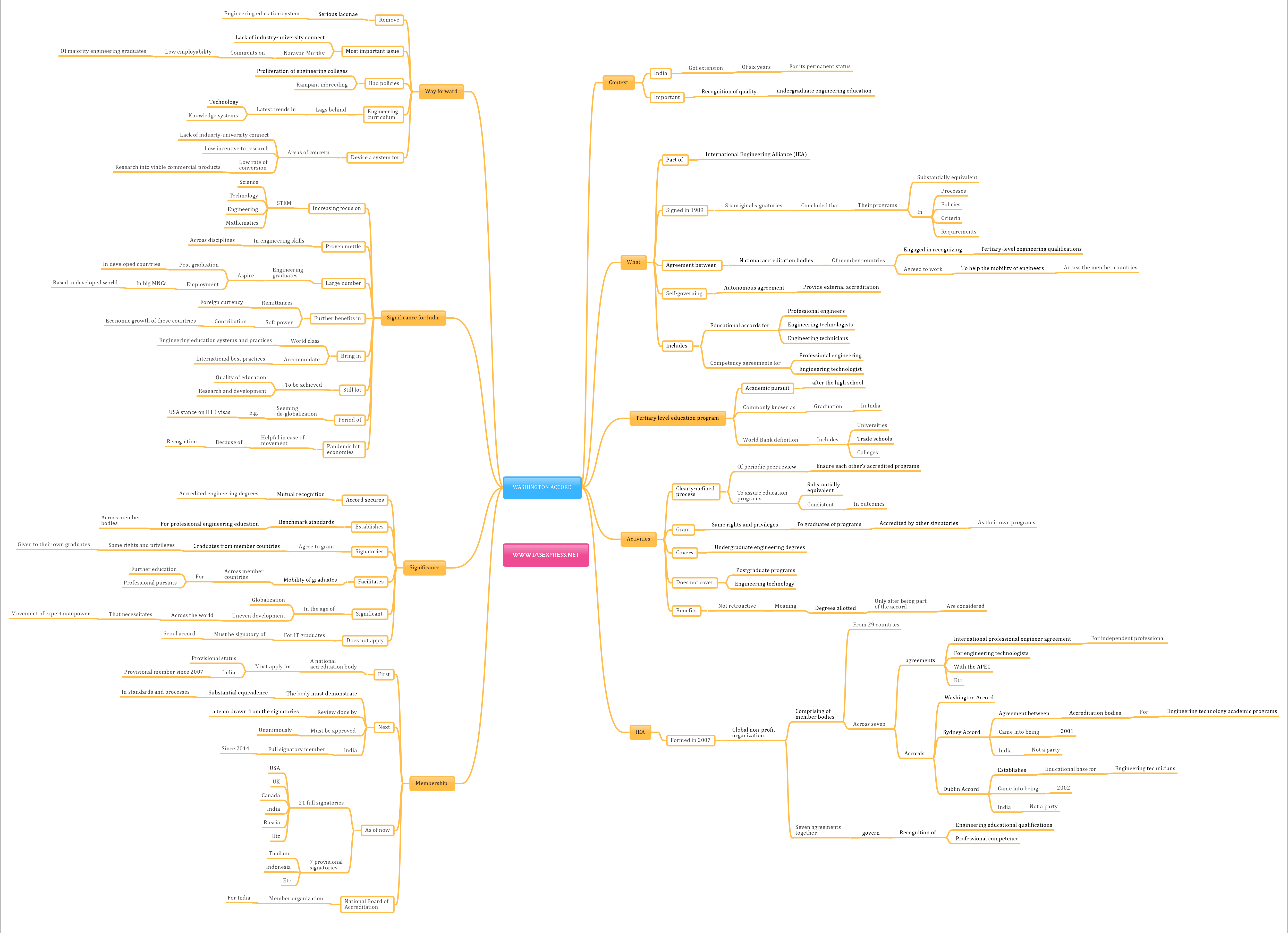Washington Accord: overview, advantages, significance for India

Recently, India’s permanent status on the Washington Accord, a constituent of International Engineering Alliance, has been extended for another six years. The membership of the Washington accord is an important recognition of the quality of undergraduate engineering education offered by India and also an opportunity to infuse a world-class system.
What is Washington Accord?
- The Washington Accord is a part of the International Engineering Alliance (IEA) that includes educational accords for professional engineers, engineering technologists and engineering technicians along with professional engineering (two) and engineering technologist (one) competency agreements.
- The Accord, which was Signed in 1989, is an agreement between national accreditation bodies of member countries engaged in recognizing tertiary-level engineering qualifications within their jurisdictions and they have agreed to work collectively to help the mobility of engineers across the member countries.
- The accord is a self-governing autonomous agreement between national organizations (signatories) that provide external accreditation to tertiary educational programs that qualify their graduates for entry into professional engineering practice.
- The tertiary level education program refers to academic pursuit undertaken after the high school, in India commonly known as undergraduate education. The World Bank defines tertiary education as including universities as well as trade schools and colleges.
What does the accord try to achieve?
- The signatories undertake a clearly-defined process of periodic peer review to ensure each other’s accredited programs are substantially equivalent and their outcomes are consistent with the published professional engineer graduate attribute exemplar.
- In 1989, the six original signatory bodies (from countries of Australia, Canada, Ireland, New Zealand, the United Kingdom, and the United States) concluded that their processes, policies, criteria, and requirements to grant accreditation to university level programs were substantially equivalent.
- They agreed to grant the same rights and privileges (accord equivalence of quality status) to graduates of programs accredited by other signatories as their own accredited programs.
- Graduates of accredited programs in the signatory country are recognized by the other signatory countries and treated as having met the professional and academic essentials in their countries.
- The Washington Accord covers undergraduate engineering degrees and does not cover the engineering technology and Postgraduate programs.
- The benefits of Accords are not retroactive. That is degrees allotted only after the signatory countries become part of the accord are recognized.
What is the International Engineering Alliance (IEA)?
- IEA is a global non-profit organization, comprising of member bodies from a total of 29 countries, across seven international agreements which it is constituted of.
- These seven international agreements together govern the recognition of engineering educational qualifications and professional competence.
- Some of the agreements are one with the APEC, the international professional engineer agreement (for independent practice), agreement for engineering technologists, etc.
- Through these accords, members of the IEA establish and enforce the bench-mark standards for engineering education and expected competence for practice in the same field.
- The Washington Accord along with Sydney Accord and Dublin Accord is part of the International Engineering Alliance.
- The Sydney Accord is an agreement between bodies that are responsible for accrediting Engineering technology academic programs. It was signed in 2001.
- Similarly, the Dublin Accord establishes the required educational base for engineering technicians. It was signed in 2002. The Dublin Accord focuses on the mutual recognition of academic programs or qualifications that form the basis for Engineering Technicians.
- Together with the three agreements for engineering practitioners, the IEA was formed in 2007, and the IEA Secretariat was created to assist with the administration of the accords and agreements and their development.
- India currently is a party only to the Washington Accord and not the other two accords.
What is the process for the membership of the Washington Accord?
- To become a signatory of the accord, a body must first apply for provisional status. India was a provisional signatory of the accord since 2007.
- To acquire the signatory status under the accord, the body must demonstrate substantial equivalence of its standards and processes. The review is done by a team drawn from the signatories. It must be approved by the unanimous agreement of the signatories. In 2014, India became a signatory member of the accord.
- As of 2019, the Washington Accord has 21 signatories with full rights to participation including the united states, United Kingdom, Canada, Ireland, Russia, China, Hong Kong, Singapore among others.
- Also, it has seven provisional signatories which include Thailand, Indonesia, Bangladesh, etc.
- The National Board of Accreditation of India is the member organization that represents India at the accord.
- National Board of Accreditation, initially established by All India Council of Technical Education under the AICTE Act, is an independent autonomous organization with the objectives of assurance of quality and relevance to technical education in the country. The professional and technical disciplines of Engineering and Technology, Management, Architecture, Pharmacy and Hotel Management come under the accreditation process of NBA.
What are the advantages of the Washington accord?
- The Accord secures mutual recognition of accredited engineering degree programs given by the member bodies. It establishes benchmark standards for professional engineering education across those bodies.
- Signatories agree to grant (or recommend to the relevant national registration body, if different) graduates of each other’s accredited programs the same recognition, rights, and privileges as they grant to graduates of their own accredited programs.
- By these provisions, the Accord facilitates the mobility of graduates between signatory jurisdictions and also makes way for a greater understanding/recognition of their engineering education and accreditation systems.
- So, it helps in mobilization of engineering graduates across the signatory territories in the pursuit of practicing engineering profession.
- It also helps in the pursuit of post-graduate studies in the signatory countries as these countries accord equivalence to undergraduate engineering programs in India.
- The recognition and portability of educational qualifications and competency has gained significance in this age of globalization alongside unbalanced development, which requisites the movement of engineering skills around the world.
- It is important to note that, according to a ToI report, the accord is not valid for IT engineers and for that we have to sign the Seoul Accord.
Why the permanent status is important for India?
- The permanent status of the accord is significant for India which is increasingly focusing on STEM (Science, Technology, Engineering Mathematics) sector to improve its human resource quality.
- India has proven its mettle in these fields before and after liberalization and the permanent status at the accord is a recognition of the growing clout of its young engineers and their acceptability at the global stage.
- Many engineering graduates aspire to move to the developed part of the world to practice their profession for the want of better opportunities and other advantages.
- They are the source of remittances and soft power propagation of our country through their engineering prowess.
- Having said that, there is still a lot to be achieved in terms of quality and sophistication in engineering education research and development.
- The accreditation helps in bringing world-class engineering education practices by accommodating some of the best practices that are part of the signatory country’s engineering education system.
- Apart from an engineering skillset and professional competence, the increasing anti-global stance of some of the leading countries when it comes to professional manpower movement across the border (the USA and its stance on H1B visa) makes it important to have such acknowledgment at the global level.
- The current onslaught of the Coronavirus pandemic has badly hit this mobility on account of physical movement restrictions. While the restrictions are being removed increasingly, the post -COVID economic situations mandate pre-eminent recognition of the kind of Washington accord to kickstart the movement of the engineering professionals.
Way Forward
- Even though India has been recognized by the Washington accord it must be noted that there are serious lacunae in the engineering education system.
- One of the most important issues raised by industry doyens in that of lack of industry-university connect.
- According to Narayan Murthy, the majority of the engineering graduates still lack the required skill set to be employed as an engineer, especially in the research and development arenas.
- It is important to make amends to this situation as quantity over quality is a recipe for disaster.
- The proliferation of engineering colleges and rampant inbreeding among them must be contained.
- The engineering curriculum even of the most reputed universities (barring respected mention of IITs) lags behind the current progress in the knowledge system in the respective disciplines.
- The lack of university-industry connect, low incentive for research and even low conversion rates of research into viable commercial products leads to the situation of brain drain.
- While we must be proud of the fact that our young engineering professionals are being recognized on the world level, it is also important to improve the above situation.
Conclusion
India needs to build over this recognition to initiate further reforms in its undergraduate engineering programs and its structures to continue on the path of excellence. The current situation of globalization demands high-quality human resources to break the protectionist barriers of the developed world and benefit from their achievements.
Practice Question for Mains
What is the Washington Accord? Explain the significance of India’s permanent status in the accord. (150 words)
If you like this post, please share your feedback in the comments section below so that we will upload more posts like this.


